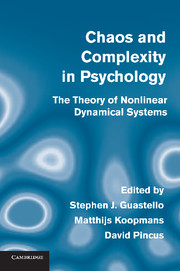Book contents
- Frontmatter
- Contents
- Contributors
- Preface
- 1 Introduction to Nonlinear Dynamics and Complexity
- 2 Collective Intelligence: Observations and Models
- 3 Neurodynamics and Electrocortical Activity
- 4 Psychophysics
- 5 Temporal and Spatial Patterns in Perceptual Behavior: Implications for Dynamical Structure
- 6 Embodied and Embedded: The Dynamics of Extracting Perceptual Visual Invariants
- 7 Origins of Order in Cognitive Activity
- 8 Nonlinear Complex Dynamical Systems in Developmental Psychology
- 9 Developmental Psychopathology: Maladaptive and Adaptive Attractors in Children's Close Relationships
- 10 Psychopathology
- 11 Coherence, Complexity, and Information Flow: Self-Organizing Processes in Psychotherapy
- 12 The Dynamics of Human Experience: Fundamentals of Dynamical Social Psychology
- 13 Group Dynamics: Adaptation, Coordination, and the Emergence of Leaders
- 14 Organizational Psychology
- 15 Complexity, Evolution, and Organizational Behavior
- 16 Agent-Based Modeling Within a Dynamic Network
- 17 Epilogue: Psychology at the Edge of Chaos
- Index
6 - Embodied and Embedded: The Dynamics of Extracting Perceptual Visual Invariants
Published online by Cambridge University Press: 18 December 2013
- Frontmatter
- Contents
- Contributors
- Preface
- 1 Introduction to Nonlinear Dynamics and Complexity
- 2 Collective Intelligence: Observations and Models
- 3 Neurodynamics and Electrocortical Activity
- 4 Psychophysics
- 5 Temporal and Spatial Patterns in Perceptual Behavior: Implications for Dynamical Structure
- 6 Embodied and Embedded: The Dynamics of Extracting Perceptual Visual Invariants
- 7 Origins of Order in Cognitive Activity
- 8 Nonlinear Complex Dynamical Systems in Developmental Psychology
- 9 Developmental Psychopathology: Maladaptive and Adaptive Attractors in Children's Close Relationships
- 10 Psychopathology
- 11 Coherence, Complexity, and Information Flow: Self-Organizing Processes in Psychotherapy
- 12 The Dynamics of Human Experience: Fundamentals of Dynamical Social Psychology
- 13 Group Dynamics: Adaptation, Coordination, and the Emergence of Leaders
- 14 Organizational Psychology
- 15 Complexity, Evolution, and Organizational Behavior
- 16 Agent-Based Modeling Within a Dynamic Network
- 17 Epilogue: Psychology at the Edge of Chaos
- Index
Summary
Perceptual Stability and Lability
Perception provides well-adapted organisms with the vital links they must establish between themselves and their environment. To do this, perception must simultaneously supply stable and reliable reference points about what the environment provides at the behavioral level and allow great flexibility in capturing information. Ideally, perception must be the agent of this compromise between stability and lability at any given time and place, in accordance with the transitory behavioral objectives that organisms target. The complexity and unpredictability of the act of perception, as well as the effect of continuity experienced at the phenomenal level, result from the interplay of these constraints. In this chapter, we present theories and a methodology to probe into the dynamics of perceptual–motor processes as they bear the emergence of perceptual constancy.
Visual Perception and Constancy of Position
Visual perception of space is what guides action in the visible world; it does so by specifying environmental features to organisms that will allow them to achieve their behavioral objectives in a mobile fashion. To fulfill this mission, visual perception must manage to keep the properties of external objects constant, despite the continuously changing projection of the images on the retina of the eye. Perceptual constancy is maintained by transcending the hiatus separating distal and proximal stimuli, that is, by bridging between the physical nature of the perceived object and the physiological stimulation of the retina.
- Type
- Chapter
- Information
- Chaos and Complexity in PsychologyThe Theory of Nonlinear Dynamical Systems, pp. 177 - 205Publisher: Cambridge University PressPrint publication year: 2008
- 2
- Cited by

